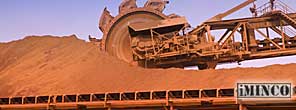 If you think Australian mining companies are losing their touch because of lower commodity prices – think again.
If you think Australian mining companies are losing their touch because of lower commodity prices – think again.
The Australian mining industry is now firmly in the grip of an industrious production phase with mining companies taking advantage of technology and automation to exceed output targets.
When exports of Australia’s coal, iron ore and other mineral wealth starts to attract media attention from around the world, it’s an good indication the good times for the industry are not behind us. Australia`s resources sector is now transitioning from a construction to a production phase, which Industry Minister Ian Macfarlane says will deliver “serious money” and boost mining exports.
“more mining jobs for Australian workers”
Export earnings are good for the country and as such one of the benefits is re-investment back into the industries that drive the export market. When money is re-invested in the mining industry, new opportunities are created to develop those projects that were previously on hold. This means more construction and mining jobs for Australian workers when these projects come on-line.
It’s predicted Australia`s export revenues will increase around 60 per cent over the next five years. This represents an annual growth rate 7 per cent and realises a total of $284 billion.
It expects Australian export growth to be fuelled by the proliferation of CSG, LNG and iron ore exports as well as a lower Australian dollar making it more attractive for other countries to do business with Australia.
Growth in export revenue will be driven by two main factors
- substantial growth in bulk commodity export volumes, particularly for LNG and iron ore; and
- a lower Australian dollar exchange rate
LNG exports are expected to increase by 360 per cent to around AUD$65 billion over the outlook period. With substantial investments in new processing and� production facilities over the past three years, production will really start to kick in.
Forecasters say Australia will very soon become the second largest – or possibly, the largest exporter of LNG in the world. That’s a staggering claim and good news for Australian mining companies and other companies who have invested heavily in the LNG sector.
Exports are set to increase across other mining sectors
In its September report, BREE said it expects metallurgical coal exports to reach $35 billion in 2017/18, growing at an annual rate of 3.2 per cent.
“Thermal coal exports are also predicted to increase”
Thermal coal exports are also predicted to increase, exceeding $24 billion in five years` time, which his an indication there are still plenty of mining job opportunities to be had.
The surge of coal exports will be more than enough to combat the anticipated drop in the the global coal price.
“Although prices for most commodities are expected to moderate over the outlook period, the projected substantial growth in export volumes of Australia`s key commodities will support growth in export earnings,”� BREE said.
Latest data from China shows iron ore import sales soar
In an update to this article (14 Oct 2013), the increase in Australian exports and the rise in China imports of iron ore are another affirmation the biggest user of iron ore is once again starting to raise itself from the self-imposed slowdown.� Strong demand from the automotive and property sectors throughout China are the reason for the import surge.
Trade figures from China indicated iron ore imports rose a phenomenal 14 per cent in September compared with the same period in 2012. Overall, Australian iron ore exports to China rose by 12.3 per cent in the first nine months to September. Exports to China accounted for 34 percent of all exports from this country. Additional figures show China is also now the worlds largest importer of oil.
Reference: Australian mining exports surge


